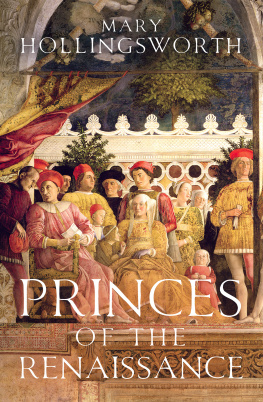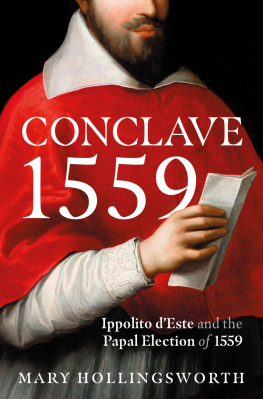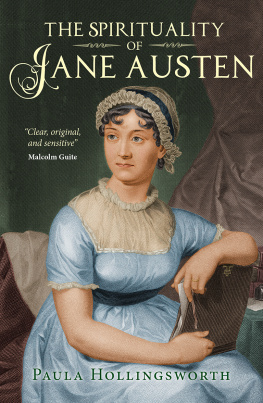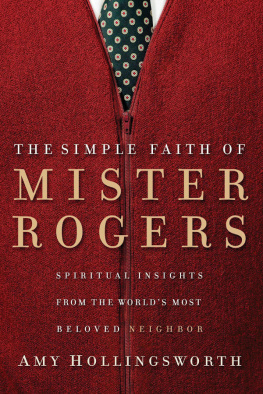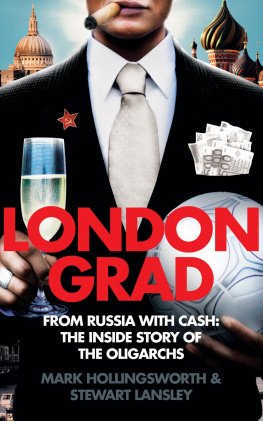Mary Hollingsworth - Princes of the Renaissance
Here you can read online Mary Hollingsworth - Princes of the Renaissance full text of the book (entire story) in english for free. Download pdf and epub, get meaning, cover and reviews about this ebook. publisher: Head of Zeus, genre: Non-fiction. Description of the work, (preface) as well as reviews are available. Best literature library LitArk.com created for fans of good reading and offers a wide selection of genres:
Romance novel
Science fiction
Adventure
Detective
Science
History
Home and family
Prose
Art
Politics
Computer
Non-fiction
Religion
Business
Children
Humor
Choose a favorite category and find really read worthwhile books. Enjoy immersion in the world of imagination, feel the emotions of the characters or learn something new for yourself, make an fascinating discovery.
- Book:Princes of the Renaissance
- Author:
- Publisher:Head of Zeus
- Genre:
- Rating:4 / 5
- Favourites:Add to favourites
- Your mark:
- 80
- 1
- 2
- 3
- 4
- 5
Princes of the Renaissance: summary, description and annotation
We offer to read an annotation, description, summary or preface (depends on what the author of the book "Princes of the Renaissance" wrote himself). If you haven't found the necessary information about the book — write in the comments, we will try to find it.
Princes of the Renaissance — read online for free the complete book (whole text) full work
Below is the text of the book, divided by pages. System saving the place of the last page read, allows you to conveniently read the book "Princes of the Renaissance" online for free, without having to search again every time where you left off. Put a bookmark, and you can go to the page where you finished reading at any time.
Font size:
Interval:
Bookmark:

PRINCES
OF THE
RENAISSANCE
Mary Hollingsworth
PRINCES
OF THE
RENAISSANCE
AN APOLLO BOOK
www.headofzeus.com

Agnolo Bronzino, Duke Cosimo I , 15434 (Florence, Uffizi). The ideal Renaissance prince was a wise ruler, generous patron of the arts and, above all, a hero on the battlefield.
Wikimedia Commons / Art Gallery of New South Wales, Sydney, Australia.
An Apollo book
First published in 2021 by Head of Zeus Ltd
2021 Mary Hollingsworth
The moral right of Mary Hollingsworth to be identified as the author of this work has been asserted in accordance with the Copyright, Designs and Patents Act of 1988.
All rights reserved. No part of this publication may be reproduced, stored in a retrieval system, or transmitted in any form or by any means, electronic, mechanical, photocopying, recording, or otherwise, without the prior permission of both the copyright owner and the above publisher of this book.
Every effort has been made to contact copyright holders for permission to reproduce material in this book, both visual and textual. In the case of any inadvertent oversight, the publishers will include an appropriate acknowledgement in future editions of this book.
A CIP catalogue record for this book is available from the British Library.
ISBN [ HB ] 9781788547833
[ E ] 9781788547826
Maps by Jeff Edwards / Isambard Thomas
Head of Zeus Ltd
58 Hardwick Street
London EC1R 4RG
www.headofzeus.com
To John and Elisabeth
INTRODUCTION
An Italian Identity
USURPERS
Alfonso of Aragon & Francesco Sforza
KNIGHTS AND HUMANISTS
Leonello dEste & Sigismondo Malatesta
A FAMILY MAN
Ludovico Gonzaga & Barbara of Brandenburg
CONSPIRACY AND GREED
Ferrante I of Naples & Federigo da Montefeltro
NEST OF VIPERS
Ludovico Sforza, Ascanio Sforza & Giangaleazzo Sforza
SURVIVORS
Isabella dEste & Alfonso dEste
A NEW POLITICAL ORDER
Francesco Maria della Rovere & Federigo Gonzaga
THE NEW ROME
Doge Andrea Gritti & his cronies
DYNASTY
Paul III & the Farnese
PRECEDENCE AND REFORM
The Este & Cosimo de Medici
CONCLUSION
Conquerors
Money was a complex business in Renaissance Italy. Each of the peninsulas many states had its own silver-based currency as well as its own system of weights and measures. Large states also issued internationally recognized gold currencies such the Venetian ducat and the Florentine florin; there was also a Roman ducat, which was replaced by the gold scudo (pl: scudi ) in 1530. For the purposes of this book, they were all were all broadly similar in value.
It is unlikely that the Renaissance would have happened without the humanists the term derives from a humanista , Renaissance student slang for the university lecturer who taught their general arts courses ( studia humanitatis ), based on the study of classical texts on history, poetry, grammar, rhetoric and moral philosophy. This revival of interest in the culture of antiquity had its origins in late thirteenth-century Padua, where a small group of literate lawyers discovered the joys of the Latin poets and historians.
It was Petrarch (130474), living in Padua after a career at the papal court in Avignon, who transformed humanism into a movement that spread rapidly across Italy. His attempts to revive the ideals of ancient Rome were an inspiration to many who followed his example by searching the monastic libraries of western Europe for the lost manuscripts of ancient authors, collecting the antique coins churned up by farmers ploughing their fields and, above all, emulating his literary efforts with their own verse, histories and learned treatises, all written in correct Ciceronian Latin or, later, in ancient Greek. By the 1450s less than a century after Petrarchs death humanism had become the dominant intellectual force in Italy.
*
Humanism fostered the sense of a uniquely Italian cultural identity, one that was distinct from that of nations beyond the Alps. It was a message that spoke eloquently to Italys princely rulers; even more so when Rome once again became the centre of the Christian world and the papacy increasingly Italian. For much of the fourteenth century the papacy had been the puppet of Europes secular monarchs, initially resident in Avignon under the protection of the French crown and then split by the Great Schism in the end there were three popes, each supported by a different bloc of rulers and each claiming to be the rightful heir to St Peter. With the credibility of the papacy at stake, in 1417 the Council of Constance ended the Schism by electing its own pope, Martin V, and his return to Rome three years later marked the point at which Renaissance Italy began to emerge as a powerful economic, political and cultural force in Europe.
From a Roman baronial family himself, it was Martin V who took the first steps to free the papacy from foreign interference, a policy that was continued by his successors, who filled the College of Cardinals with Italians. Having restored their authority in the Papal States, which had disintegrated during the absence of the papacy in Avignon, they became central figures in the politics of the peninsula, manipulating alliances between rival rulers for their own ends. They were to have a significant impact for good, and for bad on the fortunes of all the princes in this book, as well as providing them with opportunities for employment in the wars that plagued Italy throughout most of the fifteenth and sixteenth centuries.
As heirs to the mighty empire of ancient Rome, the Italians were immensely proud of their past. They could read about it in histories, and they could see it in the great ruins that were visible across the peninsula, above all in Rome itself. But it was not just Rome that could boast an imperial heritage. Mantua was the birthplace of the poet Virgil, while Catullus and Pliny the Elder both came from Verona, as did Vitruvius, whose treatise on architecture was to have such a profound impact on the visual appearance of the cities of the Renaissance princes. Padua, which had been home to the historian Livy, claimed that it had been founded by Antenor after the Trojan Wars. Julius Caesar crossed the Rubicon which still flows into the Adriatic just north of Rimini, a port which boasted an Arch of Augustus and an ancient Roman bridge. The bay of Naples had once been the playground of rich patricians and powerful emperors, while Milan was the city where Emperor Constantine signed the edict that established Christianity as an official religion in his empire.

Rimini, Arch of Augustus, 27 BC: built by Emperor Augustus to commemorate the restoration of the Via Flaminia which connected Rome with northern Italy.
Kreder Katja / Alamy Stock Photo.

Verona, Porta Borsari, c. AD 75. Originally one of the citys gates, this double arch was incorporated into the medieval fabric of Verona, its Roman origins clearly visible in the classical lettering of the inscription.
Font size:
Interval:
Bookmark:
Similar books «Princes of the Renaissance»
Look at similar books to Princes of the Renaissance. We have selected literature similar in name and meaning in the hope of providing readers with more options to find new, interesting, not yet read works.
Discussion, reviews of the book Princes of the Renaissance and just readers' own opinions. Leave your comments, write what you think about the work, its meaning or the main characters. Specify what exactly you liked and what you didn't like, and why you think so.

